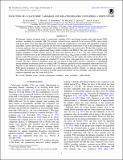EVOLUTION OF CATACLYSMIC VARIABLES AND RELATED BINARIES CONTAINING A WHITE DWARF
Author(s)
Nelson, L.; Quintin, J.; Yakut, K.; Kalomeni, Belinda; Rappaport, Saul A; Molnar, Momchil E.; ... Show more Show less
DownloadKalomeni-2016-EVOLUTION of CATACLYSMIC VARIABL.pdf (4.909Mb)
PUBLISHER_POLICY
Publisher Policy
Article is made available in accordance with the publisher's policy and may be subject to US copyright law. Please refer to the publisher's site for terms of use.
Terms of use
Metadata
Show full item recordAbstract
We present a binary evolution study of cataclysmic variables (CVs) and related systems with white dwarf (WD) accretors, including for example, AM CVn systems, classical novae, supersoft X-ray sources (SXSs), and systems with giant donor stars. Our approach intentionally avoids the complications associated with population synthesis algorithms, thereby allowing us to present the first truly comprehensive exploration of all of the subsequent binary evolution pathways that zero-age CVs might follow (assuming fully non-conservative, Roche-lobe overflow onto an accreting WD) using the sophisticated binary stellar evolution code MESA. The grid consists of 56,000 initial models, including 14 WD accretor masses, 43 donor-star masses (0.1–4.7 M[subscript ⊙]), and 100 orbital periods. We explore evolution tracks in the orbital period and donor-mass (P[subscript orb]–M [subscript don]) plane in terms of evolution dwell times, masses of the WD accretor, accretion rate, and chemical composition of the center and surface of the donor star. We report on the differences among the standard CV tracks, those with giant donor stars, and ultrashort period systems. We show where in parameter space one can expect to find SXSs, present a diagnostic to distinguish among different evolutionary paths to forming AM CVn binaries, quantify how the minimum orbital period in CVs depends on the chemical composition of the donor star, and update the P[subscript orb](M[subscript wd]) relation for binaries containing WDs whose progenitors lost their envelopes via stable Roche-lobe overflow. Finally, we indicate where in the P[subscript orb]–M[subscript don] the accretion disks will tend to be stable against the thermal-viscous instability, and where gravitational radiation signatures may be found with LISA.
Date issued
2016-12Department
Massachusetts Institute of Technology. Department of Physics; MIT Kavli Institute for Astrophysics and Space ResearchJournal
Astrophysical Journal
Publisher
IOP Publishing
Citation
Kalomeni, B. et al. “EVOLUTION OF CATACLYSMIC VARIABLES AND RELATED BINARIES CONTAINING A WHITE DWARF.” The Astrophysical Journal 833.1 (2016): 83. © 2016 The American Astronomical Society
Version: Final published version
ISSN
1538-4357